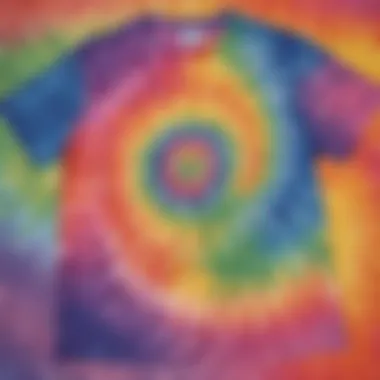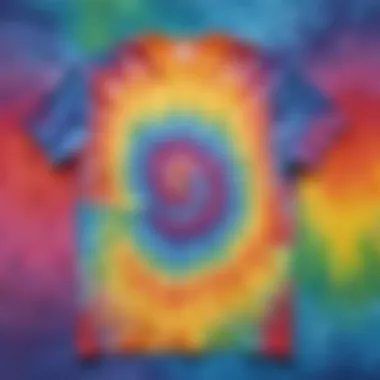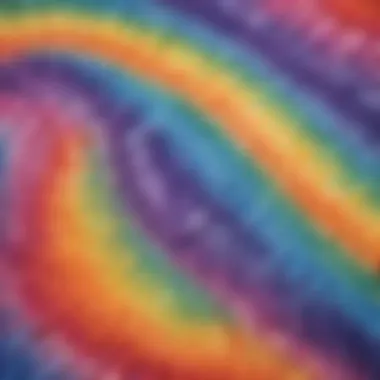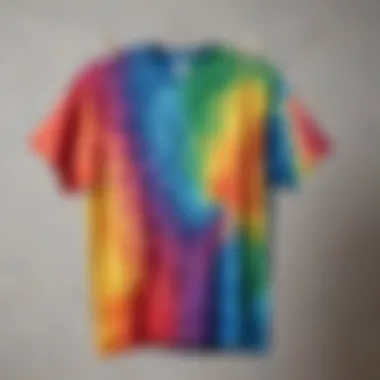Unlock Your Creativity with This Step-by-Step Tie Dye Shirt Guide


Science Fun Facts
As we embark on the colorful journey of creating tie-dye shirts, let's discover some intriguing science fun facts that underpin the magic of mixing colors and creating vibrant designs. Did you know that tie-dyeing originated from ancient resist-dyeing techniques in areas like Japan and Africa? The mesmerizing patterns we see today are a fusion of history and creativity.
Discover the Wonders of Science
In our exploration of tie-dye shirt creation, we delve into the wonders of color mixing and absorption. Understanding the science behind how different hues blend together can elevate your tie-dye artistry to the next level. Through educational videos and interactive tools, you'll grasp the scientific principles that make each dye soak into the fabric in a unique way.
Science Experiment Showcase
Now, let's roll up our sleeves and immerse ourselves in the science experiment showcase of tie-dye shirt making. With step-by-step instructions meticulously laid out, you'll learn the precise techniques to fold, twist, and bundle your shirt to achieve stunning patterns. The materials list includes colors that demonstrate color theory in action, and safety tips ensure a fun yet secure crafting experience.
Introduction to Tie-Dye Shirts
Tie-dye shirts have embedded themselves as a quintessential element of self-expression, illustrating a blend of creativity and ingenuity. In the realm of fashion and crafting, tie-dye remains a timeless art form, allowing individuals to imbue their garments with vibrant, eye-catching hues. This section serves as the gateway to a world where plain fabrics transform into masterpiece apparel, reflecting the unique personalities of those who wear them. By delving into the realm of tie-dye shirts, enthusiasts stand poised to unlock a plethora of possibilities, venturing into a realm where traditional meets contemporary. Introducing tie-dye shirts is not merely about creating clothing; it's an avenue for self-discovery, self-expression, and fostering a deep connection with creativity.
What is Tie-Dye?
Tie-dye is an ancient dyeing technique that involves manipulating fabric to create captivating patterns by restricting the penetration of the dye. It traces its roots back to multiple cultures across the globe, from Africa to Asia, highlighting its universal appeal and historical significance. This method transforms plain articles of clothing into vibrant works of art, using colors to weave a tapestry of visual delight. By intricately folding, twisting, or tying the fabric, artisans can produce mesmerizing designs that are truly one-of-a-kind.
History of Tie-Dye
The history of tie-dye is a rich tapestry woven through time, showcasing its evolution from being a cultural emblem to a contemporary fashion phenomenon. Originating in ancient civilizations, tie-dye was predominantly used in rituals and ceremonies, symbolizing spiritual meanings and societal status. As time progressed, tie-dye traversed boundaries, embracing various interpretations and applications. From the counterculture movements of the 1960s to its modern resurgence in mainstream fashion, tie-dye has endured the test of time, symbolizing freedom, creativity, and the spirit of individuality.
Materials Needed
To embark on your tie-dye shirt creation journey, it is crucial to gather the essential materials that will bring your artistic vision to life. The selection of materials plays a pivotal role in achieving vibrant and eye-catching results. Choosing the right quality fabric and dyes can greatly impact the final outcome of your tie-dye project. Additionally, having the necessary supplies on hand ensures a smooth and seamless dyeing process, allowing you to dive into the creative process without obstacles. Understanding the significance of the materials needed sets the foundation for a successful tie-dye shirt creation experience.
Fabric
Selecting the appropriate fabric for your tie-dye project is key to achieving the desired results. Cotton fabric is highly recommended for tie-dyeing due to its excellent absorbency, which allows the dyes to penetrate effectively, resulting in bright and long-lasting colors. Alternatively, you can opt for natural fibers like rayon or hemp, which also yield beautiful dyeing outcomes. It is advisable to prewash the fabric to remove any sizing or impurities that may hinder the dye absorption process. Ensuring that the fabric is clean and ready for dye application sets the stage for vibrant and durable tie-dye designs.
Dyes
The selection of dyes is a critical aspect of the tie-dye process, as it determines the color vibrancy and longevity of the final product. Procuring high-quality, vibrant dyes in a variety of colors allows for endless creative possibilities. It is recommended to use fiber reactive dyes specifically formulated for tie-dyeing, as they bond well with the fabric fibers, resulting in colorfast and wash-resistant designs. Paying attention to the dyeing instructions and ratios is essential to achieving consistent and appealing color gradients in your tie-dye creations.
Other Supplies


In addition to fabric and dyes, several other supplies are essential for a successful tie-dye project. Utensils such as rubber bands, gloves, and plastic squeeze bottles for dye application are indispensable tools in creating intricate patterns and designs. Furthermore, having a spacious work area with protective coverings to prevent dye spills and stains is paramount. Additional items like plastic bags for dye setting and mixing containers for preparing dye solutions contribute to a well-organized and efficient tie-dyeing process. Ensuring that you have all the necessary supplies ready before starting your project streamlines the crafting experience and prevents disruptions during the creative process.
Preparing the Fabric
The stage of Preparing the Fabric is a critical starting point in the tie-dye process, laying the foundation for vibrant and long-lasting designs. High-quality fabric selection is key, emphasizing natural fibers like cotton for optimal dye absorption and durable results. The preparatory phase involves pre-washing the fabric to remove any residues that may hinder the dye's penetration. Ensuring a clean and dry fabric surface is essential for achieving vivid and colorfast tie-dye patterns.
Additionally, prepping the fabric may involve folding or twisting it to create intricate patterns or designs. Careful attention to detail during this stage can significantly impact the final outcome of the tie-dye project. Choosing the right fabric manipulation technique can elevate the visual appeal of the finished shirt, making each piece a unique work of art.
Considerations for Preparing the Fabric extend to the workspace setup as well. A designated work area with protective coverings is advisable to prevent accidental spills or stains. Maintaining a tidy and organized workspace not only enhances efficiency but also contributes to a safer creative environment, especially when involving younger participants in the tie-dye process.
Moreover, understanding the fabric's absorbency properties is crucial when applying dyes. Some fabrics may require specific pre-treatment procedures to ensure optimal color saturation and pattern definition. Exploring different fabric options and adjusting the preparation techniques accordingly can result in visually striking tie-dye creations.
Tie-Dye Techniques
This section explores the essence of tie-dye techniques within the broader context of creating tie-dye shirts. Mastering tie-dye techniques is crucial in achieving unique and vibrant shirt designs that can showcase your creativity and personality. By delving into various tie-dye methods, individuals can unleash their artistic flair and experiment with diverse patterns and color combinations. Understanding the intricacies of each technique allows for precise application of dyes and helps in creating visually stunning results that stand out from regular tie-dye creations.
Spiral Technique
The spiral technique in tie-dye is a classic method that produces mesmerizing spiral patterns on fabric. To commence, securely pinch the fabric at the center and spiral it in a clockwise or counterclockwise direction, based on your preference. Use rubber bands to bind the spiraled fabric firmly, ensuring the sections are equally divided to maintain symmetry. Application of dye on the spiral results in striking multi-colored rings when the fabric unfolds. Experimenting with different color placements and dye saturation levels can yield diverse outcomes, allowing for a range of visually appealing designs that are distinct and artistic.
Crumple Technique
The crumple technique offers a free-form approach to tie-dye, where fabric is scrunched or crumpled in a random manner to create intricate patterns. This method allows for spontaneous dye application without strict structural guidelines, fostering a sense of creative freedom and unpredictability in the design process. By crumpling the fabric unevenly and applying dyes liberally, you can achieve a blend of colors and shapes that form a unique tapestry on the material. Embracing the organic nature of the crumple technique results in one-of-a-kind patterns that evoke a sense of artistic expression and spontaneity.
Stripes Technique
The stripes technique involves folding or pleating the fabric to create distinct, parallel lines for dye application. By methodically folding the fabric in uniform or varied widths, you can develop a pattern of stripes that can range from bold and structured to subtle and intricate. Careful consideration of color selection and stripe width contributes to the overall aesthetic appeal of the finished shirt. The stripes technique offers versatility in design, allowing for experimentation with different folding methods and color schemes to produce visually captivating and well-defined stripes on the fabric.
Reverse Tie-Dye
Reverse tie-dye provides a unique twist to traditional tie-dyeing by reversing the color removal process instead of adding colors. This technique involves bleaching areas of a dark-colored fabric to create light or white patterns against the colored background. By strategically applying bleach in patterns or designs, you can unveil contrasting motifs that offer a striking visual contrast. The reverse tie-dye technique requires precision and control during the bleaching process to achieve desired patterns effectively. Embracing the unconventional nature of reverse tie-dye can result in eye-catching shirts with a contemporary and artistic flair.
Applying the Dye
In the realm of tie-dye shirt creation, the application of dye holds a momentous significance. This pivotal stage is where the magic truly unfolds, where colors blend and designs take shape. The process of applying dye is not merely about color application but a transformative act that turns a plain garment into a work of art. Each brushstroke of dye carries the artist's intention, adding depth and character to the fabric.
When diving into the act of applying dye, one must consider various elements to ensure a successful outcome. Firstly, the choice of dye plays a fundamental role. Whether opting for traditional fiber-reactive dyes or exploring eco-friendly alternatives, selecting high-quality, vibrant dyes is crucial for achieving desired results. Understanding color theory and how different hues interact can also elevate the final product, allowing for the creation of mesmerizing patterns and shades.
Furthermore, the technique employed during dye application can significantly impact the overall look of the finished tie-dye shirt. From the meticulous placement of colors in a spiral pattern to the freer-flowing nature of the crumple technique, each approach offers distinctive results. Experimenting with various techniques not only adds diversity to one's creations but also fosters creativity and a deeper understanding of dyeing processes.


Amidst the artistic exploration, consideration of the fabric type is essential during the dye application phase. Different fabrics react uniquely to dyes, with natural fibers like cotton absorbing colors more vibrantly compared to synthetic materials. Understanding the characteristics of the fabric being dyed influences color intensity and longevity, ensuring a durable and visually striking tie-dye shirt.
As one delves into the intricacies of applying dye, patience and precision emerge as virtues to uphold. Taking the time to carefully apply dyes, ensuring adequate saturation without oversaturation, and allowing colors to meld harmoniously are vital practices. Attention to detail in how dye penetrates the fabric can dictate the clarity of patterns and the overall aesthetics of the final piece.
In essence, applying dye to a tie-dye shirt is not just a step in the crafting process but a form of artistic expression. It is a symphony of colors, techniques, and fabric interactions that culminate in a wearable masterpiece. Mastering the art of dye application opens a world of creativity and self-expression, inviting individuals to imbue their garments with personal flair and style.
Setting the Dye
In the realm of tie-dye shirt creation, the significance of Setting the Dye should not be underestimated. This crucial step ensures that the vibrant colors you have meticulously applied to your fabric remain vivid and long-lasting, resisting fading or bleeding during wear and wash. Setting the dye essentially 'locks in' the colors, transforming your canvas of fabric into a masterpiece of hues that will withstand the test of time.
The process of Setting the Dye involves heat setting the colored fabric using either an iron, a dryer, or a steamer. Each method has its advantages and considerations, influencing the final outcome of your tie-dye creation. Heat setting helps the dye molecules bond securely with the fabric fibers, preventing color loss and ensuring colorfastness. It is essential to follow the specific instructions provided with the dye you have used to guarantee optimal results.
When considering the benefits of Setting the Dye, durability and color retention are paramount. By properly setting the dye, you ensure that your tie-dye shirt maintains its brilliance even after multiple washes, allowing you to flaunt your creation confidently without the fear of colors fading prematurely. Moreover, a well-set dye minimizes color bleeding, thus preserving the integrity of your design and preventing undesirable color transfer onto other garments in the laundry.
As you embark on the journey of tie-dye shirt creation, take a moment to reflect on the importance of Setting the Dye. This crucial step not only elevates the visual appeal of your masterpiece but also contributes to its longevity. Embrace the meticulous nature of this process, pay attention to the recommended setting techniques, and savor the transformation of your ordinary fabric into a kaleidoscope of colors that will endure countless style statements.
Rinsing and Washing
When it comes to tie-dye shirts, the rinsing and washing process is a crucial step that can make or break your vibrant creations. After applying the dyes and setting them, rinsing and washing ensure the colors stay put and the fabric remains soft and wearable. This step is not just about removing excess dye but also about securing your design for long-lasting enjoyment. Proper rinsing and washing techniques can enhance the longevity of your tie-dye shirts while preserving the integrity of your colorful patterns.
To begin the rinsing process, fill a basin or sink with cold water. Gently submerge your dyed fabric and allow it to soak for several minutes. Slowly knead the fabric under the water, helping to release any remaining excess dye. The cold water helps to keep the colors from bleeding or fading prematurely.
Once you have thoroughly soaked and kneaded the fabric, it's time to move on to the washing stage. Using a mild detergent, gently hand wash your tie-dye creation. Avoid harsh scrubbing or twisting as this can distort the patterns or cause the colors to blend together. Rinse the fabric until the water runs clear, ensuring all excess dye is removed.
After washing, consider giving your tie-dye shirt a final rinse with a mixture of water and white vinegar. This step can help to set the colors further and prevent them from running in future washes. Once rinsed, gently squeeze out any excess water without wringing the fabric. If needed, you can opt to repeat the rinsing and washing process until the water runs clear.
When drying your tie-dye shirt, lay it flat on a clean towel and roll the fabric to remove excess moisture. Avoid direct sunlight as it can cause the colors to fade. Instead, opt for a shady spot or a drying rack indoors. Once fully dried, your tie-dye creation is ready for flaunting, showcasing your artistic flair and creative prowess. Remember, proper rinsing and washing not only maintain the vibrancy of your tie-dye shirts but also ensure a comfortable wearing experience for years to come.
Drying and Finishing Touches
Drying and finishing touches hold significant importance in the tie-dye shirt creation process. It is not merely about drying the shirt but also adding those final embellishments that elevate the overall look of the garment. This stage ensures that the colors set properly and the design stands out vibrantly. Proper drying techniques can affect the longevity of the dye on the fabric. When considering finishing touches, individuals can personalize their tie-dye shirts further, making each piece unique and expressive of their creativity. The final steps of the process bring closure to the artistic journey, culminating in a wearable art piece that reflects the individual's style and skill in tie-dye techniques.
Air Drying vs. Machine Drying
When it comes to drying tie-dye shirts, individuals have the option to choose between air drying and machine drying. Air drying is a more natural approach, allowing the shirt to dry at its own pace without the introduction of external heat sources. This method is gentle on the fabric and is generally preferred for delicate materials. On the other hand, machine drying offers a quicker solution, using heat to expedite the drying process. While this method is efficient, it may cause some colors to fade or bleed if not done carefully. Individuals need to consider the fabric type and dye used before deciding on the drying method to ensure the best results in color preservation and overall garment quality.
Adding Embellishments
Enhancing tie-dye shirts with embellishments is a creative way to take the design to the next level. Whether it's through sequins, beads, embroidery, or fabric paint, embellishments can add texture, dimension, and a personalized touch to the garment. When selecting embellishments, it's essential to consider the overall design of the shirt and the desired aesthetic. Adding embellishments after dyeing and drying the shirt allows for precise placement and ensures that the additions complement the tie-dye patterns. Care should be taken not to overpower the tie-dye design but rather to enhance it subtly. The choice of embellishments can vary based on individual preferences, ranging from intricate details to simple accents, providing countless possibilities for customizing tie-dye shirts to suit one's unique style.


Tips for Achieving Success in Creating Tie-Dye Shirts
When embarking on the journey of creating tie-dye shirts, it is essential to equip oneself with the necessary knowledge and strategies to ensure a successful outcome. Here, we delve into key tips to help you navigate this creative process with finesse and precision.
Understanding Color Combinations
One fundamental aspect of tie-dye artistry is understanding how different colors interact and blend with each other. Before beginning your project, take the time to experiment with color combinations. Understanding color theory can elevate your design from amateur to professional.
Quality Materials Matter
Selecting high-quality materials is paramount in achieving vibrant and long-lasting tie-dye creations. Invest in good-quality dyes and fabrics that hold color well. Lesser-quality materials may result in faded designs that lose their vibrancy over time.
Mastering Dye Application Techniques
To achieve intricate and visually appealing patterns, it is crucial to master various dye application techniques. From the classic spiral to the modern crumple technique, each method offers a unique result. Understanding how to control dye flow and intensity will greatly impact the final look of your tie-dye creation.
Embracing Imperfections
One of the beauties of tie-dye art is its unpredictability. Embrace the imperfections and irregularities that arise during the dyeing process. These quirks often add character and charm to your finished work, making each piece unique and distinctive.
Patience and Precision
Tie-dye artistry requires a steady hand and patience. Take your time when applying dyes and creating patterns. Rushing through the process may lead to smudged designs or uneven color distribution. Precision and attention to detail are key to achieving professional-looking tie-dye shirts.
Experimentation and Creativity
Don't be afraid to step outside the box and experiment with different techniques and designs. Creativity knows no bounds in the world of tie-dye. Mix and match colors, try new folding techniques, and let your imagination run wild. The beauty of tie-dye lies in its versatility and endless possibilities.
Safety Precautions
In our journey of creating tie-dye shirts🌈 , we must not overlook the critical aspect of safety precautions. Ensuring safety measures are in place is paramount to safeguard both creators and the environment. When working with dyes and chemicals, it is imperative to protect our skin and eyes from potential harm. By wearing gloves, goggles, and aprons, we can prevent skin irritation and accidental exposure to harmful substances.
Moreover, adequate ventilation in the dyeing area is essential to disperse fumes effectively. This reduces the risk of inhaling noxious vapors that can be harmful to our respiratory system. Additionally, working in a well-ventilated space minimizes the concentration of chemicals in the air, promoting a safer working environment.
Furthermore, it is crucial to handle dyes and chemicals with care and follow the manufacturer's instructions diligently. Mixing dyes improperly or using them in an unintended manner can pose risks not only to our health but also to the quality of our tie-dye creations. Adhering to the recommended safety guidelines ensures a successful dyeing process while mitigating potential hazards.
In the pursuit of creating stunning tie-dye shirts, safety precautions should never be overlooked. By prioritizing safety, we not only protect ourselves and those around us but also enhance the enjoyment of our crafting experience. Remember, safety first to embark on a creative journey filled with colorful possibilities!
Conclusion
The Conclusion section of this article serves as a vital component in wrapping up the comprehensive guide on creating tie-dye shirts. Throughout the various stages of the process, from understanding the history of tie-dye to selecting suitable materials and applying dyeing techniques, this section brings together all the elements discussed. It highlights the significance of experimentation and creativity in tie-dye projects, encouraging readers to embrace the uniqueness of each creation. By emphasizing the satisfaction and fulfillment that come from crafting personalized tie-dye shirts, the Conclusion resonates with both beginners and experienced crafters. Additionally, it reinforces the idea that art and self-expression can transcend conventional boundaries.
Enjoy Your Unique Tie-Dye Creation!
The subsection 'Enjoy Your Unique Tie-Dye Creation!' encapsulates the essence of the tie-dye art form, celebrating the joy and pride that one feels when admiring a finished tie-dye masterpiece. It underscores the importance of embracing imperfections and viewing them as part of the charm of handmade items. Encouraging readers to appreciate the intricacies and nuances of each design, this section inspires a sense of ownership and satisfaction in one's creative endeavors. Furthermore, it prompts individuals to share their creations with others, spreading the spirit of creativity and self-expression in a communal setting. Ultimately, 'Enjoy Your Unique Tie-Dye Creation!' encourages a sense of accomplishment and pride in the DIY process, reinforcing the notion that creativity knows no bounds.







